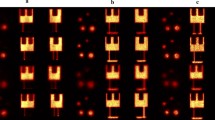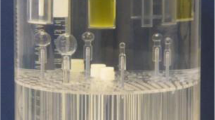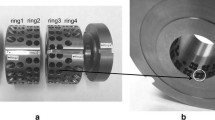Abstract
Purpose
The aim of this study is to evaluate the impact of scanning multiple mice simultaneously on image quantitation, relative to single mouse scans on both a micro-positron emission tomography/computed tomography (microPET/CT) scanner (which utilizes CT-based attenuation correction to the PET reconstruction) and a dedicated microPET scanner using an inexpensive mouse holder “hotel.”
Methods
We developed a simple mouse holder made from common laboratory items that allows scanning multiple mice simultaneously. It is also compatible with different imaging modalities to allow multiple mice and multi-modality imaging. For this study, we used a radiotracer (64Cu-GB170) with a relatively long half-life (12.7 h), selected to allow scanning at times after tracer uptake reaches steady state. This also reduces the effect of decay between sequential imaging studies, although the standard decay corrections were performed. The imaging was also performed using a common tracer, 2-deoxy-2-[18 F]fluoro-d-glucose (FDG), although the faster decay and faster pharmacokinetics of FDG may introduce greater biological variations due to differences in injection-to-scan timing. We first scanned cylindrical mouse phantoms (50 ml tubes) both in a groups of four at a time (multiple mice mode) and then individually (single mouse mode), using microPET/CT and microPET scanners to validate the process. Then, we imaged a first set of four mice with subcutaneous tumors (C2C12Ras) in both single- and multiple-mice imaging modes. Later, a second set of four normal mice were injected with FDG and scanned 1 h post-injection. Immediately after completion of the scans, ex vivo biodistribution studies were performed on all animals to provide a “gold-standard” to compare quantitative values obtained from PET. A semi-automatic threshold-based region of interest tool was used to minimize operator variability during image analysis.
Results
Phantom studies showed less than 4.5 % relative error difference between the single- and multiple-mice imaging modes of PET imaging with CT-based attenuation correction and 18.4 % without CT-based attenuation correction. In vivo animal studies (n = 4) showed <5 % (for 64Cu, p > 0.686) and <15 % (for FDG, p > 0.4 except for brain image data p = 0.029) relative mean difference with respect to percent injected dose per gram (%ID/gram) between the single- and multiple-mice microPET imaging mode when CT-based attenuation correction is performed. Without CT-based attenuation correction, we observed relative mean differences of about 11 % for 64Cu and 15 % for FDG.
Conclusion
Our results confirmed the potential use of a microPET/CT scanner for multiple mice simultaneous imaging without significant sacrifice in quantitative accuracy as well as in image quality. Thus, the use of the mouse “hotel” is an aid to increasing instrument throughput on small animal scanners with minimal loss of quantitative accuracy.





Similar content being viewed by others
References
Henkelman M (2010) Systems biology through mouse imaging centers: experience and new directions. Ann Rev Biomed Eng 12:143–166
Agdeppa ED, Spilker ME (2009) A review of imaging agent development. The AAPS Journal 11:286–299
Hargreaves RJ (2008) The role of molecular imaging in drug discovery and development. Clin Pharmacol Ther 83:349–353
Ahn BC (2011) Applications of molecular imaging in drug discovery and development process. Curr Pharm Biotechnol 12:459–468
Medarova Z, Pham W, Kim Y, Dai G, Moore A (2006) In vivo imaging of tumor response to therapy using a dual-modality imaging strategy. Int J Cancer 118:2796–2802
Michalski MH, Chen X (2011) Molecular imaging in cancer treatment. Eur J Nucl Med Mol Imaging 38:358–377
Pike LS, Tannous BA, Deliolanis NC et al (2011) Imaging gene delivery in a mouse model of congenital neuronal ceroid lipofuscinosis. Gene Ther 18:1173–1178
Yong J, Rasooly J, Dang H et al (2011) Multimodality imaging of B-cells in mouse models of type I and II diabetes. Diabetes 60:1383–1392
Lyons S (2005) Advances in imaging mouse tumour models in vivo. Journal of Pathology 205:194–205
Golestani R, Wu C, Tio RA et al (2010) Small-animal SPECT and SPECT/CT: application in cardiovascular research. Eur J Nucl Med Mol Imaging 37:1766–1777
Roncali E, Cherry SR (2011) Application of silicon photomultipliers to positron emission tomography. Annals of Biomedical Engineering 39:1358–1377
Hamilton CS, Ma Y, Smith SD, Benveniste H (2007) High resolution 3D in vivo mouse brain imaging at 9.4 T bruker MRI systemBioengineering Conference, 2007 NEBC '07 IEEE 33rd Annual Northeast, pp. 45-46.
Hong H, Yang Y, Cai W (2011) Imaging gene expression in live cells and tissues. Cold Spring Harbor Protoc: 354-365.
Kluanberg BA, Davis JA (2008) Considerations for laboratory animal imaging center design and setup. ILAR J 49:4–16
Pauux AL, Ong LC, Teh I, et. al. (2011) Comparison of imaging techniques to monitor tumor growth and cancer progression in living animals. Int J Mol Imaging doi:10.1155/2011/321538 .
Chen TE, Yoder KK, Normandin MD et al (2009) A rat head holder for simultaneous scanning of two rats in small animal PET scanners: design, construction, feasibility testing and kinetic validation. J Neurosci Methods 176:24–33
Bock NA, Konyer NB, Henkelman RM (2003) Multiple-mouse MRI. Magnetic Resonance Med 49:158–167
Dazai J, Spring S, Cahill LS, Henkelman RM (2011) Multiple-mouse neuroanatomical magnetic resonance imaging. J Vis Exp: e2497.
Siepel FJ, Van Lier MGJTB, Chen M et al (2010) Scanning multiple mice in a small-animal PET scanner: influence on image quality. Nuclear Instruments and Methods in Physics Research A 621:605–610
Disselhorst JA, Boerman OC, Oyen WJG, Slump CH, Visser EP (2010) Spatial resolution of the Inveon small-animal PET scanner for the entire field of view. Nuclear Instruments and Methods in Physics Research A 615:245–248
Aide N, Cd D, Ml B, Meryet-Figuiere M, Poulain L (2010) High-throughput small animal PET imaging in cancer research: evaluation of the capability of the Inveon scanner to image four mice simultaneously. Nuclear Medicine Communications 31:851–858
Sheruma N, Peter LK, Wencke L, Steven R M (2006) Maximizing the useful field of view of the microPET: feasibility of imaging large animals, IEEE Nuclear Science Symposium Conference Record 1853-1856
Aide N, Visser P, Lheureux S, Heutte N, Szanda I, Hicks R (2012) The motivations and methodology for high-throughput PET imaging of small animals in cancer research. Eur J Nucl Med Imaging 30:1497–1509
Ren G, Blum G, Verdoes M et al (2011) Non-invasive imaging of cysteine cathepsin activity in solid tumors using a 64Cu-labeled activity-based probe. PLoS ONE 6:e28029
Srinivas M, Dhurairaj T, Basu S, Bural G, Surti S, Alavi A (2009) A recovery coefficient method for partial volume correction of PET images. Ann Nucl Med 23:341–348
Acknowledgments
The authors acknowledge the use of imaging instruments and image analysis support in the Stanford Imaging Facility. This work was supported by grants NCI P50 CA114747 and NIH U54 CA119367 and by the Stanford Cancer Center.
Conflict of Interest
No other potential conflict of interest relevant to this article exists.
Author information
Authors and Affiliations
Corresponding author
Rights and permissions
About this article
Cite this article
Habte, F., Ren, G., Doyle, T.C. et al. Impact of a Multiple Mice Holder on Quantitation of High-Throughput MicroPET Imaging With and Without Ct Attenuation Correction. Mol Imaging Biol 15, 569–575 (2013). https://doi.org/10.1007/s11307-012-0602-y
Published:
Issue Date:
DOI: https://doi.org/10.1007/s11307-012-0602-y




